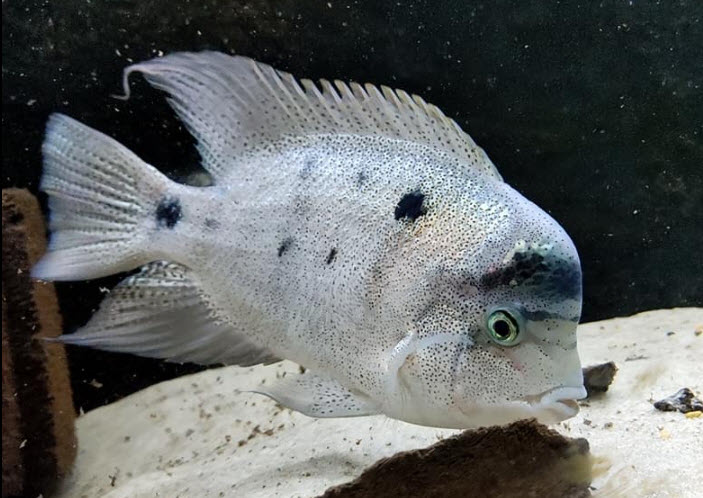It is beneficial for most aquariums to add a bag of crushed coral to the filter. This buffers the water to 7.6 to 7.9 pH. This pH is great for all fish, contrary to popular mythology. Also beneficial is using crushed coral, oolitic limestone sand or aragonite sand as a substrate. These substrates see very wide use in African cichlid aquariums.

Both crushed coral and aragonite will typically become “coated” with a very insoluble phosphate compound over the span of years when used as a substrate. So it will need to be replaced very infrequently when used as a buffering substrate.
And planted tanks typically do not do well with crushed coral, oolitic limestone sand or aragonite sand as a substrate. The buffering action prevents absorption of iron and phosphate into the roots of the plants.

Abstract of Test
A test was run on buffering substrate. Limestone rock, coral, aragonite, crushed coral and crushed shells all buffered very slightly acid 6.6 pH water up to a 7.6 to 7.9 pH quite well. Since 7.6 to 7.9 pH is an excellent pH for virtually all fish it is an excellent idea to add one form or another of calcium carbonate to the aquarium and just leave it there.

Procedure
Spring water from the store was acidified, aerated and titrated over the span of a few weeks to a stable 6.6 pH. This water was then put into seven bottles. Rocks and substrate were added to the bottles. The pH was measured over a span of 120 days. One bottle had baking soda added as an additional experiment.
Resultaten
These were the results of the buffering substrate testing:
| Behandeling | 1 day | 4 days | 16 days | 32 days | 120 days |
|---|---|---|---|---|---|
| Geen | 6.65 | 6.70 | 6.61 | 6.83 | 7.16 |
| Limestone Rock | 6.83 | 7.44 | 7.57 | 7.49 | 7.90 |
| Coral pieces | 6.97 | 7.36 | 7.48 | 7.53 | 8.15 |
| Crushed Coral | 7.44 | 7.50 | 7.54 | 7.64 | 8.03 |
| Crushed Shells | 7.51 | 7.42 | 7.58 | 7.53 | 8.04 |
| Aragonite Sand | 7.61 | 7.53 | 7.70 | 7.49 | 7.35 |
| Baking Soda | 7.89 | 7.78 | 8.12 | 8.10 | 9.05 |
Note the pH was tested with two titrated and adjusted meters, two test strips, and the API pH test. The numbers are solid. The water was initially at 6.8 pH, dGH 6, dKH of 0. It was well aerated for two weeks and titrated to 6.6 pH, dGH 6 and dKH of 0.

An Initial Test
Initially the test was run with the spring water without acidifying it or aerating it and different numbers were obtained:
| Behandeling | 1 day | 2 days | 4 days | 8 days | 16 days | 32 days |
|---|---|---|---|---|---|---|
| Geen | 6.84 | 7.08 | 7.44 | 7.38 | 7.49 | 7.60 |
| Limestone Rock | 6.83 | 7.11 | 7.48 | 7.41 | 7.67 | 7.57 |
| Coral pieces | 6.83 | 7.11 | 7.44 | 7.29 | 7.58 | 7.51 |
| Crushed Coral | 6.86 | 7.09 | 7.34 | 7.27 | 7.85 | 7.61 |
| Crushed Shells | 6.87 | 7.10 | 7.27 | 7.19 | 7.55 | 7.48 |
| Aragonite Sand | 6.84 | 7.10 | 7.26 | 7.17 | 7.69 | 7.54 |
| Baking Soda | 7.49 | 7.56 | 7.68 | 7.58 | 7.85 | 7.93 |
The water with nothing in it went from 6.84 pH to 7.6 pH over 32 days. So this test was no good. This data showed that the water (spring water from the store) had a lot of carbon dioxide in it which needed to be removed by acidification and aeration before running a good test. So the test was redone, which gave the first set of numbers.


Discussie
Both tests together show that buffering materials which are calcium carbonate are beneficial in the aquarium as a pH of 7.5 to 7.9 is a very good pH for almost all freshwater tropical fish.
The 120 day tests were interesting but not pertinent to anyone who does any sort of water changes.
For more on how a pH of 7.6 to 7.9 is good for almost any fish click on this link:


